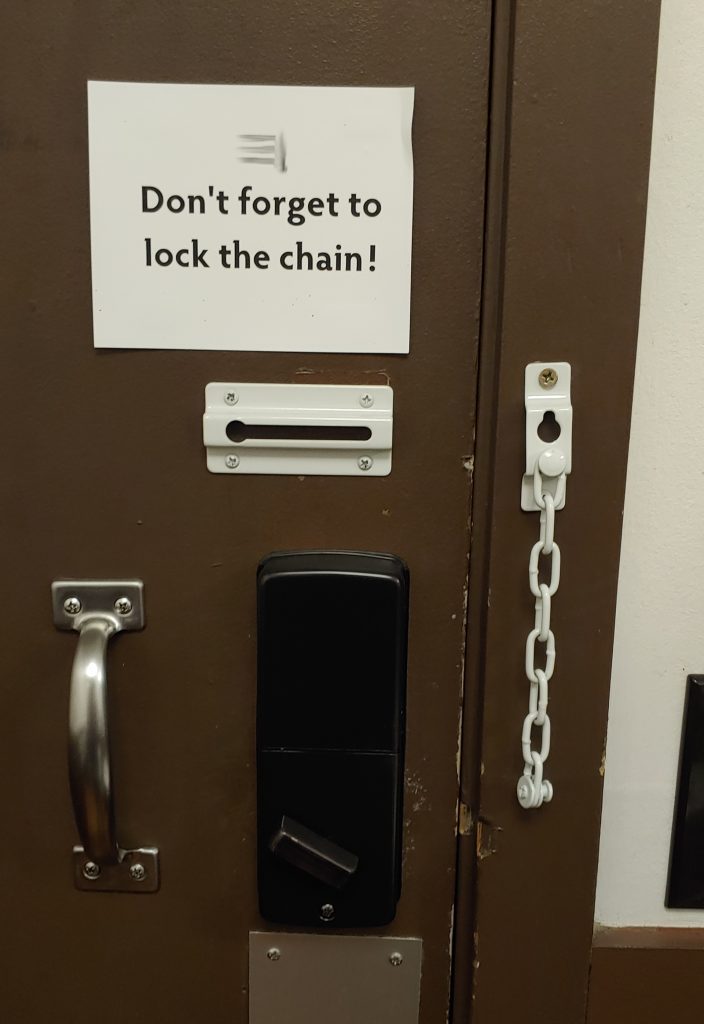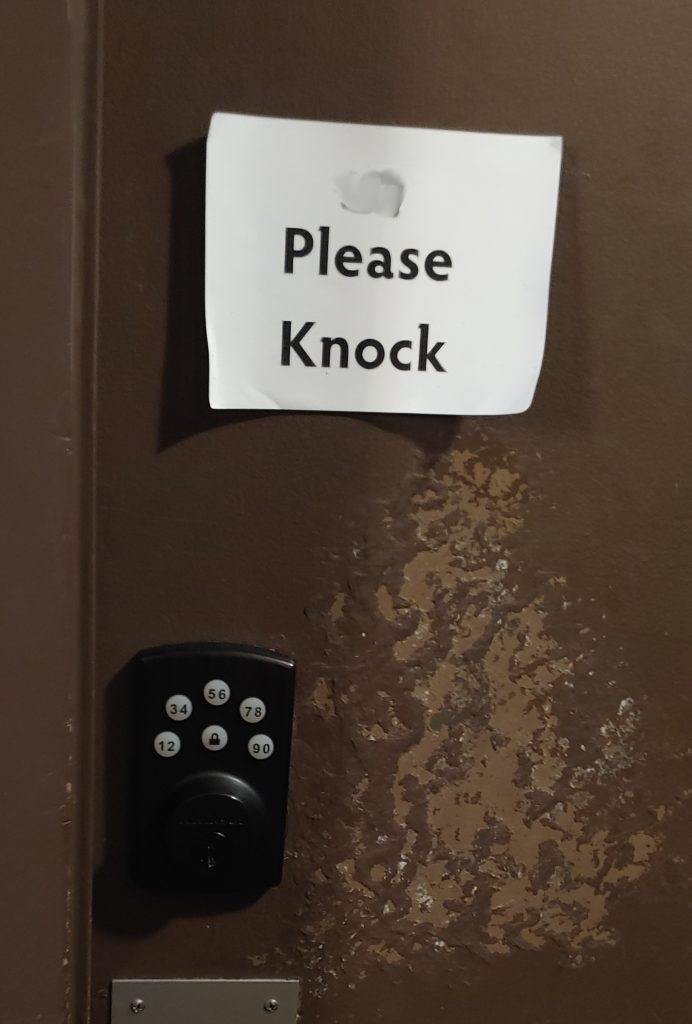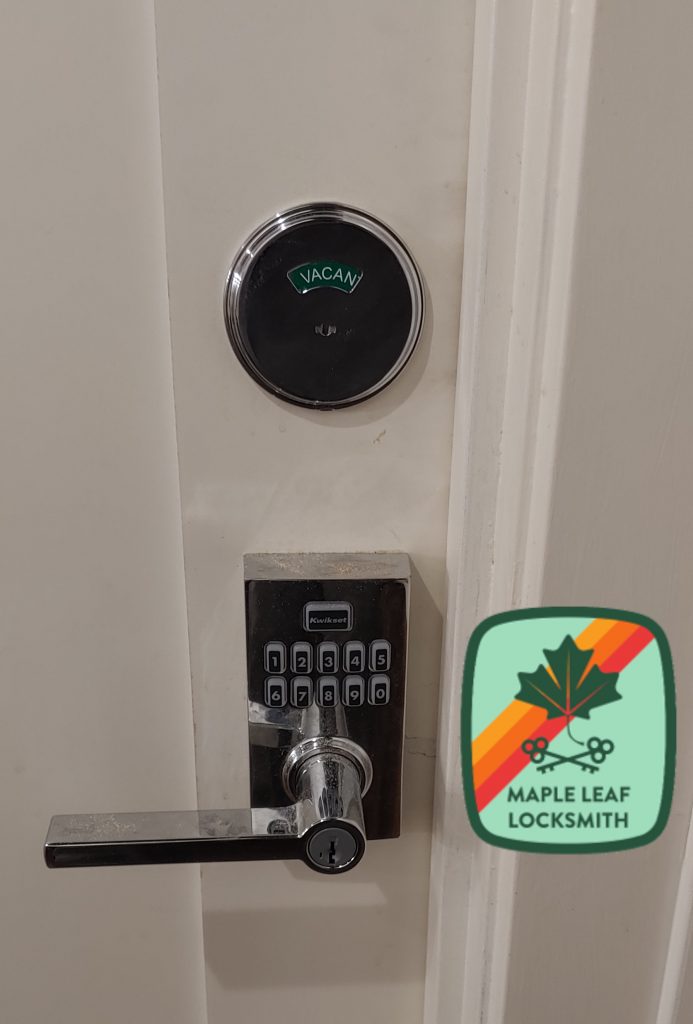Places serving the public have people that need to use the bathroom. If the bathroom is only a toilet and a sink these people will want privacy; probably only one person at a time is the goal. This can be accomplished in a few different ways:
- by tying a key to a large stick so that people don’t forget to give it back or walk out with it
- installing a hotel lock or slide bolt
- installing a keyed deadbolt
- installing a privacy lock
- installing an electronic lock in conjunction with a privacy deadbolt
- installing an electronic lock with a privacy feature


First we should think about the purpose of the bathroom lock. Frequently the security of the public bathroom is poorly thought out. The object is to allow patrons access without letting drug abusers access. It’s not my bathroom but many business owners try to restrict access to drug abusers because they will shoot up and then pass out for a long period of time while occupying the bathroom, keeping paying customers from using it. Worse still, an overdose may occur leaving the staff with a dead body. For this reason a simple privacy lock isn’t sufficient for the big city. Ideally whatever setup is employed will unlock the door when the bathroom occupant exits. It’s a drag for staff to unlock the bathroom when it is left locked accidentally.
With that in mind, here are some common setups:
- The common privacy handleset. These are great for private settings or for places where drug abuse isn’t as big an issue. After the door shuts one can lock the door by pushing a button. People can’t tell if the bathroom is occupied so they may try to open the door which is unsettling for people in the bathroom and embarrassing for the person trying to gain access. The door can still be opened from the outside with a paperclip or quarter or small screwdriver depending on the model. These don’t limit unauthorized access at all.
- The passage handleset and a privacy deadbolt. These also don’t limit unauthorized access. Their only benefit over the privacy handleset is that others can see that the bathroom is already occupied. They can still be unlocked from the outside with a special key.
- The locking knob or locking deadbolt. These require a key to open, usually obtained by asking the staff for the key. Since there is only one key available people can’t walk in on each other. Often the staff only have the one copy of the key so if somebody takes it inside with them they can remain as long as they want but at least the staff can limit who gets access to the bathroom.
- The passage handleset and the slidebolt or hotel lock. These don’t allow people to know the bathroom is occupied. They also don’t allow anybody else access in case of an emergency. You just have to kick down the door.
- An electronic lockset. These use a code which allows staff to limit who gets the code. Unfortunately anybody with the code can open the door and if it is a small bathroom that is embarrassing for all involved.
- An electronic lockset with privacy function. Alarm Lock and others make cool locks that allow you to give out a code that also disables access with the same code until the door is opened. Occupancy is also indicated on the outside of the door. In the case of the Alarm Lock, a small yellow led light turns on. In my humble opinion this is a great development but the small yellow led is not enough of an indication. People still don’t realize the bathroom is occupied until they try the door first and then see the yellow led.
- An electronic lock with a privacy deadbolt. This allows controlled access to the bathroom along with a way to indicate occupancy of the bathroom. In case of an emergency the bathroom can be unlocked from the outside.
These are the most common setups. The cheapest is the slide bolt, only slightly more expensive than a sock on the door. It’s not suitable for the needs of business owners in the city. A keyed solution is the next cheapest. As long as the staff has a spare copy they can unlock the door in case of an emergency. Add a privacy deadbolt to show occupancy status and it’s pretty solid but unfortunately for whatever reason staff usually doesn’t keep a copy so a drug abuser could lock themselves inside.
My favorite solution is either to masterkey the bathroom to allow for the front door key to work as well as the bathroom key (people are much more careful with the front door key) along with a privacy deadbolt, or an electronic lock with a privacy deadbolt. Both solutions allow for staff to unlock the door in an emergency but also indicate occupancy to others in a public setting.

